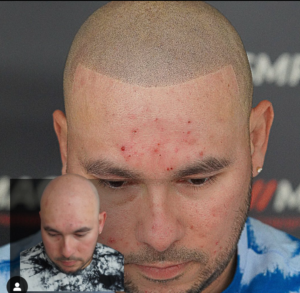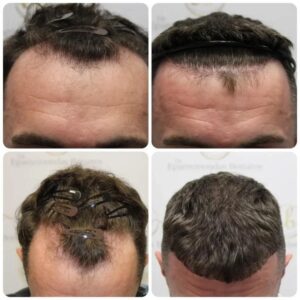Every season has its impact on humans, including the hair cycle. It’s a typical sign of hair shedding when you wake to see hairs on your bed or lose it when combing. You might start to feel concerned when you see this. But, in most cases, it will stop by itself except in hair loss circumstances.
Shedding hair in the summer is common, and there are reasons for this occurrence. Before you panic, you need to understand what is happening, which could be seasonal hair loss. Hair enters a shed phase towards the end of summer, which could be rapid than you ever imagined.
We propose this guide to simplify the ambiguity surrounding hair shedding. This content will give insights into the hot weather effect on human hair.
Table of Contents
Key Takeaway
Hair shedding involves falling out of hair, gradual or rapid, depending on the season. The growth of new hair after shedding implies the completion of a cycle. However, if the growth does not match what you shed, there is a hair loss problem. Prominent places to see shed hair include comb, finger, brush, bed, and clothes. Humans can shed as much as 100 hair follicles in a day during summer.
What is Hair Shedding?
Hair shedding is the natural process of losing hair. It is a normal part of the hair growth cycle; everyone sheds hair daily. According to Medical News Today, the average person sheds between 50 and 100 hairs daily. However, during the summer months, some people may shed up to 150 hairs per day.
In females, various factors contribute to hair shedding, such as female pattern baldness, where hair loss follows a distinct pattern influenced by genetics; immune system fluctuations that can trigger hair fall; polycystic ovary syndrome affecting hair growth as a health condition; the impact of color perm treatments leading to hair fall; and the risk of traction alopecia from avoiding tight hairstyles, all culminating in a large amount of hair loss unless proactive measures are taken to stop growing the cycle.
Is Shedding of Hair in the Summer Real?
To many people, hair shedding in the summer is a mystery. But it is a fact confirmed by research that more hair follicles part ways with the body during summer. The reason why it happens is as a result of the hair follicle getting to the resting phase. The medical term for this is telogen effluvium.
Summer is famous for harsh weather. Exposure of the human hair to this condition forces it to enter the resting phase early. When this happens, hair shedding will increase rapidly, twice the number of hair that should fall out. Women can testify to this during the hot summer.
Understanding hair loss requires that you are conversant with the hair cycle. Seven stages of hair loss occur under different durations. The anagen phase lasts up to seven years, catagen stays for only a few weeks, and telogen lasts up to four months. Once the cycle is complete, hair shedding occurs for a new cycle to begin.
Why Does Hair Shed More in Summer?
There are a few reasons why hair sheds more in summer. One reason is that the sun’s ultraviolet (UV) rays can damage the scalp and hair follicles. This damage can lead to hair loss. Additionally, the heat and humidity of summer can dehydrate the scalp and hair, making them more prone to breakage and shedding.
How to Prevent Summer Hair Loss
There are a few things you can do to prevent summer hair loss:
- Protect your scalp from the sun. Wear a hat or use a leave-in conditioner with SPF protection when outside for an extended period.
- Keep your scalp and hair hydrated. Drink plenty of water and use a shampoo and conditioner designed to hydrate hair.
- Avoid heat styling. Heat styling tools can damage hair and make it more prone to breakage.
- Eat a healthy diet. A healthy diet rich in vitamins and minerals can help promote healthy hair growth.
- Manage stress. Stress can contribute to hair loss. Find healthy ways to manage stress, such as yoga or meditation.
When to See a Doctor
If you are concerned about hair loss or notice that you are losing more hair than usual, it is important to see a doctor. There may be an underlying medical condition that is causing your hair loss.
The Telogen Effluvium Effect
Except you know a lot about the hair growth cycle, you probably don’t understand what telogen implies. Hair falling out in the summer depends largely on telogen. It determines whether you will lose a little or a significant strand of hair when the temperature is high.
Humans shed hair daily, and we could lose as much as 100 hair follicles per day. Anything above that implies that other factors are causing the fall out on your body. It could be hormonal changes or diet, or a higher level of telogen. According to research, women possess a significant level of telogen in summer.
It implies a premature resting phase that forces more hair to fall out. There will be a halt to hair growth in the follicle. For clarification, nothing is wrong with hair getting to this phase. But, a higher telogen level implies hair loss beyond normal.
Seasonal hair loss can be attributed to high temperature that stimulates telogen to increase. This outcome is losing up to 70% of hair compared to 30% is within the acceptable range. It signals a premature resting phase, which is not usual.

Is it a Permanent Condition?
Fortunately, your hair will grow again when the summer season ends. The temporal effect will vanish when a new season comes around, as you will start seeing improved hair. Suppose other factors cause your hair loss. In that case, your hair may not grow back.
You can completely forget about the hair shed at the beginning of a new cycle. You may grow more hair than what you lost after replacement with fuller hair. Seeing a hair specialist might benefit you if your seasonal hair loss develops a pattern.
A good example is when baldness is becoming noticeable. The hair in the front view is disappearing with replacement. Seeking professional advice will be helpful to prevent it before it gets out of hand.
FAQs:
Why is my hair shedding so much?
Hair shedding is a normal part of the hair growth cycle. On average, we shed about 50 to 100 hairs per day. However, if you notice that you are shedding more hair than usual, there may be an underlying cause.
Here are some of the most common causes of excessive hair shedding:
- Stress: Stress can trigger telogen effluvium, which causes hair to shed excessively. This is usually temporary and will resolve once the stressor is removed.
- Hormonal changes: Hormonal changes, such as those that occur during pregnancy, childbirth, menopause, or after starting or stopping birth control pills, can also cause hair loss.
- Nutritional deficiencies: Hair loss can also be caused by a deficiency in specific nutrients, such as iron, biotin, or zinc.
- Medical conditions: Some medical conditions, such as thyroid disease, lupus, or alopecia areata, can also cause hair loss.
- Medications: Certain medications, such as chemotherapy drugs, blood thinners, and antidepressants, can cause hair loss as a side effect.
- Styling habits: Heat styling, tight hairstyles, and harsh hair care products can all damage hair and cause it to break or fall out.
How can I stop my hair from falling out?
The best way to stop hair loss depends on the underlying cause. If you are experiencing excessive hair shedding, seeing a doctor to rule out any underlying medical conditions is vital.
Here are some general tips for preventing hair loss:
- Reduce stress: Find healthy ways to manage stress, such as exercise, yoga, or meditation.
- Maintain a healthy diet: Eat a balanced diet with plenty of fruits, vegetables, and whole grains.
- Get enough sleep: Aim for 7-8 hours of sleep per night.
- Be gentle with your hair: Avoid heat styling, tight hairstyles, and harsh hair care products.
- Consider topical treatments: Several over-the-counter and prescription topical treatments can help to slow or stop hair loss.
Does hair regrow after shedding?
In most cases, hair will regrow after shedding. However, the rate at which hair grows back can vary from person to person. If you are concerned about hair loss, talk to your doctor. They can help you determine the cause of your hair loss and recommend the best treatment options.
How long is the shedding phase of hair?
The shedding phase of hair typically lasts for a few months. However, the duration can vary depending on the underlying cause. If you are experiencing excessive hair shedding, being patient and consistent with your treatment plan is essential.
Conclusions
Summer hair shedding is a normal part of the hair growth cycle. However, there are a few things you can do to prevent it. Following the tips in this blog post can help keep your hair healthy and strong all summer.
Finally, don’t feel distressed when you notice hair shedding during summer. It’s not unusual because telogen comes into play when the weather is hot. The positive side of it is that you will get back your hair when the new hair growth cycle begins. If you need help maintaining your hair, hair specialists can offer you the best advice.



